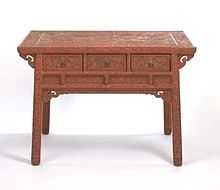Chinese lacquerware table
From Wikipedia, the free encyclopedia

Chinese lacquerware table, 1425-1436 V&A Museum no. FE.6:1 to 4-1973
This lacquerware table is from the Ming Dynasty (1368-1644). It is unique in shape and decoration and is one of the most important objects from the period. It is one of the few surviving examples in the world of a major piece of furniture produced in the 'Orchard Workshop', the Imperial lacquer workshop set up in the early Ming period and situated to the north-west of the 'Forbidden City' compound in Peking (now Beijing). The table bears the mark of the reign of the Emperor Xuande (1426-35) and was probably made to stand in an Imperial Palace. An Imperial provenance is also suggested by the five-clawed dragons carved on the surface, each of which have been strangely mutilated by the removal of one claw on each foot.
Bibliography
- Jackson, Anna (ed.) (2001). V&A: A Hundred Highlights. V&A Publications.
External links
This article is issued from Wikipedia. The text is available under the Creative Commons Attribution/Share Alike; additional terms may apply for the media files.